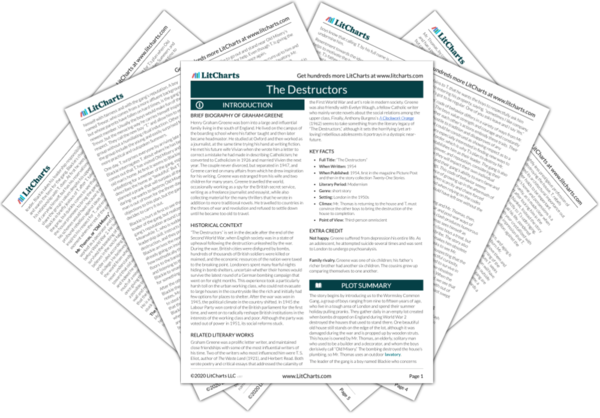“The Destructors” not only depicts class difference and conflict between the Wormsley Common Gang and Mr. Thomas, but also probes deeper to examine the codes of behavior that drive the way the boys of the gang and Mr. Thomas think and act.
Mr. Thomas believes in a world of rigid hierarchies, in which the lower class should naturally show deference to their “betters” in the upper class, and the upper class should, in turn, patronize the lower class and show it a certain amount of (condescending) kindness. He also sees the young as bound to treat their elders with respect. He believes in a world of tradition, order, and propriety, in which the social niceties are followed. He sums up his way of seeing the world when he explains to T. that he wants the boys to respectfully ask him before entering his property, saying, “sometimes I like company. Only it’s got to be regular. One of you asks leave and I say Yes.”
The boys’ code of behavior differs in a variety of ways from Mr. Thomas’s. The boys value strength and courage and constantly assess whether each other’s actions embody these traits. Their code is also hostile to tradition and disapproves of any statement that could be construed as showing respect as to a superior. They are especially interested in finding new ways to challenge the old order, which is why T.’s plan to destroy Mr. Thomas’s house establishes him as their leader. The gang is also focused on success, power, and reputation, considering their actions based on how they will impact their own individual status within the gang and their gang’s ability to earn fame and the respect of other gangs. This code of behavior seems derived from the experience of growing up in the aftermath of the war, a time in London when scarcity and chaos forced competition and struggle, and when relying on the codes established before the war would have left one without the skills needed to survive.
The interactions between the gang and Mr. Thomas, then, present a clash of codes, or pre-war and post-war ways of seeing the world. In some cases, this clash produces humorous misunderstandings, as when Mr. Thomas sees himself as benevolently giving some young lower-class boys a treat, but they interpret his gift of chocolates as a bribe. The story also shows, however, how Mr. Thomas’s code makes him obsolete and blind to reality. For instance, when T. asks to see Mr. Thomas’s house, the old man obliges, never suspecting that the boy could be motivated by anything but respectful curiosity. Mr. Thomas’s blindness to the attributes needed to survive in the reshaped post-war world, founded on his now-obsolete code, is what allows the boys to destroy his home. When the lorry driver laughs at Mr. Thomas at the story’s end, we see that he shares the gang’s ethos and its belief that those with out of date codes deserve to have their connections to the past swept away.
Codes of Behavior ThemeTracker

Codes of Behavior Quotes in The Destructors
There was every reason why T., as he was afterwards referred to, should have been an object of mockery - there was his name (and they substituted the initial because otherwise they had no excuse not to laugh at it), the fact that his father, a former architect and present clerk, had 'come down in the world' and that his mother considered herself better than the neighbours. What but an odd quality of danger, of the unpredictable, established him in the gang without any ignoble ceremony of initiation?
He was just, he had no jealousy, he was anxious to retain T. in the gang if he could. It was the word 'beautiful' that worried him - that belonged to a class world that you could still see parodied at the Wormsley Common Empire by a man wearing a top hat and a monocle, with a haw-haw accent. He was tempted to say, 'My dear Trevor, old chap,' and unleash his hell hounds.
T. stood with his back to the rubble like a boxer knocked groggy against the ropes. He had no words as his dreams shook and slid. Then Blackie acted before the gang had time to laugh, pushing Summers backward. 'I'll watch the front, T.,' he said, and cautiously he opened the shutters of the hall.
He said to the boy beside him, 'I'm not unreasonable. Been a boy myself. As long as things are done regular. I don't mind you playing round the place Saturday mornings. Sometimes I like company. Only it's got to be regular. One of you asks leave and I say Yes. Sometimes I'll say No. Won't feel like it. And you come in at the front door and out at the back. No garden walls.'
















